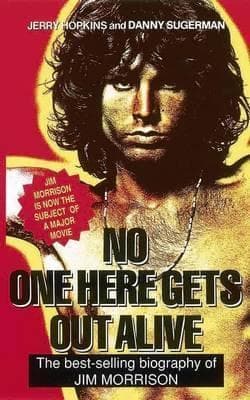
Book Review Summary: No One Here Gets Out Alive. Jerry Hopkins and Daniel Sugerman
Introduction
"No One Here Gets Out Alive" by Jerry Hopkins and Daniel Sugerman is a biography that delves into the life and legacy of Jim Morrison, the enigmatic lead singer of The Doors. This book has garnered both praise and criticism from readers, who have shared their thoughts on the book's content, style, and overall impact. In this article, we will analyze the common opinions and feelings expressed by readers, summarize the reasons for recommending or not recommending this book, and provide a conclusion that captures the essence of the book's reception.
About Jerry Hopkins
Jerry Hopkins is an author and journalist known for his extensive knowledge of popular culture. He has written numerous books, including biographies on Elvis Presley and Jim Morrison, as well as essays on music and film. Hopkins' writing style is characterized by his ability to capture the essence of his subjects and provide insightful analysis. His collaboration with Daniel Sugerman on "No One Here Gets Out Alive" showcases his expertise in exploring the lives of influential figures in music history.
Analysis of Views
-
Engaging Storytelling: Many readers found the book engaging and enjoyable to read. The authors' storytelling style captivated them, making them feel like they were part of the narrative. The book's pacing was praised for keeping readers hooked from start to finish.
-
In-Depth Research: Readers appreciated the extensive research that Hopkins and Sugerman conducted for the book. They felt that the authors had uncovered new insights and details about Jim Morrison's life, providing a comprehensive understanding of his journey. The depth of research was seen as a significant strength of the book.
-
Personal Connection: Some readers expressed a personal connection with Jim Morrison and his music. They found the book to be a celebration of Morrison's artistry and a tribute to his legacy. The authors' admiration for Morrison and their ability to convey his essence resonated with these readers.
-
Limited Depth: A few readers felt that the book lacked depth in certain areas. They felt that the authors focused more on recounting Morrison's self-destructive behavior and less on exploring his artistic contributions. Some readers felt that the book could have delved deeper into Morrison's literary influences and his aspirations as a poet.
-
Quotations and Accuracy: A few readers expressed concerns about the accuracy of certain quotes and conversations presented in the book. They questioned the reliability of word-for-word quotations from people who were involved in events that occurred decades ago. While some readers appreciated the inclusion of firsthand accounts, others felt that it could have been handled with more caution.
Reasons for Recommendation
-
Engaging Narrative: The book's engaging narrative style captures readers' attention from start to finish. Readers found it difficult to put down and appreciated the authors' ability to weave a compelling story around Jim Morrison's life and legacy.
-
Comprehensive Research: The extensive research conducted by Hopkins and Sugerman adds depth to the book's content. Readers felt that they gained a better understanding of Morrison's life, his artistic contributions, and the cultural context in which he existed. The thoroughness of the research was seen as a significant reason for recommending the book.
-
Personal Connection: For readers who have a personal connection with Jim Morrison and his music, this book serves as a celebration of his legacy. They found it to be a fitting tribute to a talented musician who left an indelible mark on popular culture. The authors' admiration for Morrison resonated with these readers, making them feel invested in his story.
Reasons for Not Recommendation
-
Limited Depth: Some readers felt that the book lacked depth in certain areas, particularly in exploring Morrison's artistic contributions beyond his music. They felt that the authors focused too much on recounting his self-destructive behavior and less on delving into his literary influences and aspirations as a poet. These readers felt that the book could have offered more insight into Morrison's creative process and intellectual pursuits.
-
Quotations and Accuracy: A few readers expressed concerns about the accuracy of certain quotes and conversations presented in the book. They questioned the reliability of word-for-word quotations from people who were involved in events that occurred decades ago. While some readers appreciated the inclusion of firsthand accounts, others felt that it could have been handled with more caution or clarity regarding its accuracy.
Conclusion
"No One Here Gets Out Alive" by Jerry Hopkins and Daniel Sugerman is a biography that has garnered both praise and criticism from readers. The book's engaging narrative style, comprehensive research, and personal connection to Jim Morrison's life and legacy have resonated with many readers, making it a recommended read for fans of The Doors and music history enthusiasts alike. However, some readers felt that the book lacked depth in certain areas, particularly in exploring Morrison's artistic contributions beyond his music, and raised concerns about the accuracy of certain quotes and conversations presented in the book. Overall, "No One Here Gets Out Alive" offers a unique perspective on Jim Morrison's life, capturing both his complex personality and his enduring influence on popular culture.